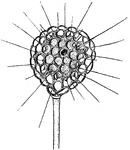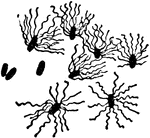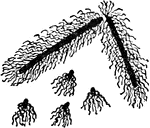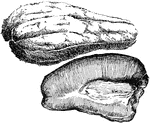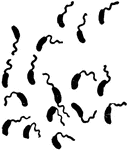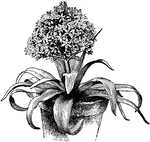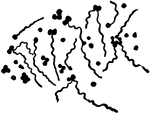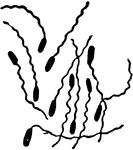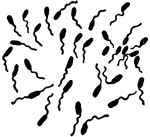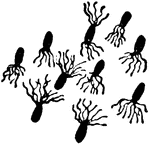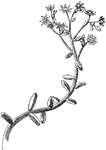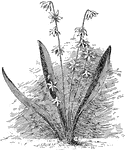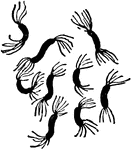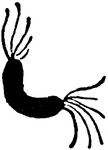Acinetæ
"An order of the class Infusoria, the adult members of which have no cilia and no proper mouth, and…

Trumpet Animalcule
"They are trumpet-animalcules of the family Stentoridae, with the peristome divided into two lappet-like…

Sempervivum Arachnoideum
This perennial is of the sempervivum family; featuring furry central rosettes.
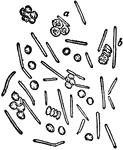
Bacillus Anthracis
"Bacilli mingles with blood-corpuscles from the blood of a guinea-pig; some of the bacilli dividing."…
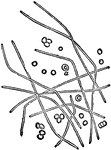
Bacillus Anthracis
"The rodlets after three hours' culture in a drop of aqueous humour. They grow out into long leptothrix-like…
Bacillus Megaterium
"A pair of bacilli actively growing and dividing." — The Encyclopedia Britannica, 1910

Bacillus Megaterium
"A rodlet in this condition (but divided into four segments) after treatment with alcoholic iodine solution."…

Bacillus Megaterium
"Successive stages in the development of the spores." — The Encyclopedia Britannica, 1910
Bacillus Megaterium
"A rodlet segmented in four, each segment containing one ripe spore." — The Encyclopedia Britannica,…
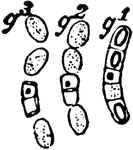
Bacillus Megaterium
"Early stages in the germination of the spores (after being dried several days)." — The Encyclopedia…

Bacillus Megaterium
"Successive stages in the germination of the spore." — The Encyclopedia Britannica, 1910
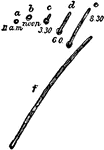
Bacillus Ramosus
"The various phases of germination of spores of Bacillus ramosus, as actually observed in hanging drops…
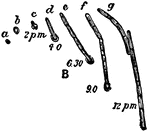
Bacillus Ramosus
"The various phases of germination of spores of Bacillus ramosus, as actually observed in hanging drops…
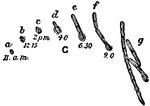
Bacillus Ramosus
"The various phases of germination of spores of Bacillus ramosus, as actually observed in hanging drops…

Bacillus Ramosus
"The various phases of germination of spores of Bacillus ramosus, as actually observed in hanging drops…

Bacillus Subtilis
"Bacillus subtilis, Cohn, and Spirillum undula, Ehrenb." — The Encyclopedia Britannica, 1910

Cercomonad Flagellate
"A colony of Cercomonas termo, a typical flagellate infusorian." -Whitney, 1911

Clostridium
"Germination of spore of Clostridium butyricum—the axis of growth coincides with the long axis…
Cocci
"A chair of cocci of Leuconostoc mesenterioides, with two "resting spores," i.e. anthrospores." —…

Diagrams of Foraminifera
"Diagrams of Foraminifera. A, monothalamian; B, C, polythalamian; D, horizontal, and E, F, vertical…
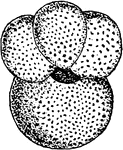
Globigerina
"Globigerina bulloides. GLOBIGERINIDAE. A family of chiefly pelagic foraminiferous rhizopods, with the…
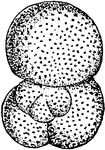
Globigerina
"Globigerina bulloides. GLOBIGERINIDAE. A family of chiefly pelagic foraminiferous rhizopods, with the…

Gregarina
"Gregarina, contents divided into pseudo-navicellae. GREGARINIDAE. A family or other major group of…
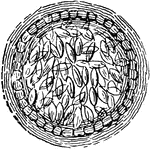
Gregarina
"Gregarina, contents divided into pseudo-navicellae. GREGARINIDAE. A family or other major group of…

Gregarina
"Gregarina, free pseudo-navicellae. GREGARINIDAE. A family or other major group of endoplastic protozoans,…
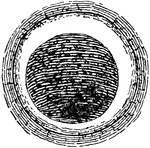
Gregarina Encysted
"Gregarina of Earthworm, encysted. GREGARINIDAE. A family or other major group of endoplastic protozoans,…
Gregarina of Earthworm
"Gregarina of Earthworm. GREGARINIDAE. A family or other major group of endoplastic protozoans, having…

Amoebiform Gregarina
"Gregarina, their free amoebiform contents. GREGARINIDAE. A family or other major group of endoplastic…
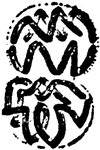
Myconostoc
"Colonies of Myconostoc enveoped in diffluent matrix." — The Encyclopedia Britannica, 1910

Myconostoc
"Colonies of Myconostoc enveoped in diffluent matrix." — The Encyclopedia Britannica, 1910

Myconostoc
"Colonies of Myconostoc enveoped in diffluent matrix." — The Encyclopedia Britannica, 1910

Peanut Worm - Interior Anatomy of Adult
Sipunculus nudus. A species of unsegmented marine worm, commonly called the peanut worm. "A, One fourth…

Smilacina Racemosa
This flowering plant belongs to the ruscaceae, which are common in North America.
Rodlet
"A motile rodlet with one cilium and with a spore formed inside." — The Encyclopedia Britannica,…

Rotifer
A rotifer or wheel animalcule (Floscularia ornata) is a microscopic animal named for the cilia used…
Rotifers
The rotifers or wheel-animalcules are relatively small and beautiful organisms, rarely ever longer that…

Sarcomastigophora
The phylum Sarcomastigophora belongs to the Protist kingdom and it includes many unicellular or colonial,…
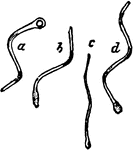
Schizomycetes
"Spore-formation in Vibrio-like (c) and Spirillum-like (a, b, d) Schizomycetes." — The Encyclopedia…

Spirillum
"Spirillum containing many spores (a), which are liberated at b by the breaking up of the parent cells."…

